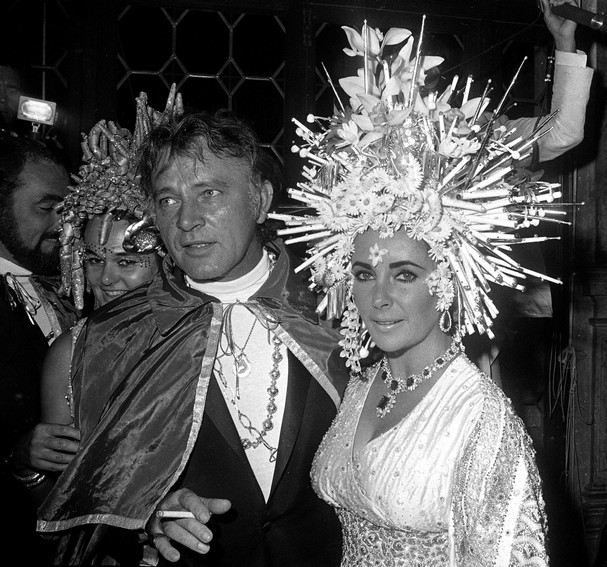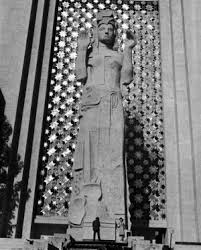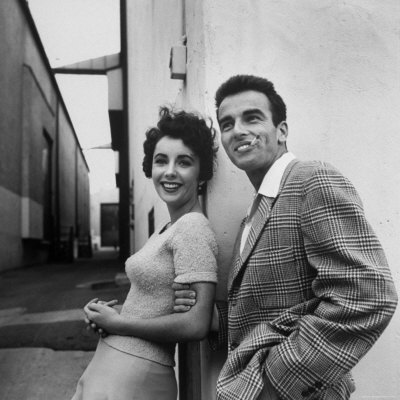I am done with this frog pond, these mean little town blues for homeless loons that has no room for real ideas, especially, BIG IDEAS! There will be no Godzilla Festival competing with the Eugene Celebration that has been presented by the kindred of Ken Kesey. I am moving Ken back to the Bay Area where he lived for awhile so that he may be part of the Raising of Atlantis and the presenting of the Atlantean Grail to the world. For this move I bring out my BIG GUN, my kindred Elizabeth Rosemond Taylor, who was the Muse for Hollywood Royalty that the Christian-right, and Osama Bin Laden, declared cultural warfare on.
Watch this video. Isn’t it clear the Republican-Church wants our nation to fail, wants to see our great cities to go down for the sake of country bumpkins who are bored out of their wits? What is this loon talking about? Who is her audience?
Since 911, American has buried it head in the sand. We are not the America we used to be. Millions are considering casting votes for Sarah Palin again so they can be entertained while they clutch their guns and their Bible down in their End Time bunkers. Pat Robertson suggests his fearful senior followers take out a second mortgage in order to pay off their afterlife debt instead of putting their grandchildren thru college.
The photograph of Bogart’s boat, is the most beautiful photograph I have ever seen. My father’s High School chums sat atop the TransAmerican Title pyramid. They asked Victor to come on board, but, he wanted to sail the bay alone.
Jon Presco
http://www.rockethub.com/dashboard/managed_projects
After the Oakland Hills Fire, my friend Michael took me up to Taurus street and showed me the ruins of Peter Stackpole’s home wherein valuable works of art and photography was destroyed. This was a monumental loss to the art world, and to the creative culture that made the Bay Area a Mecca to Bohemian Souls from all over the world.
Ralph Stackpole was a friend of George Sterling and stayed with him and the artists and poets that gathered at Lake Temescal in Oakland. Ralph befriended Diego and Freda Rivera the famous muralist and artist. Ralph helped design the Paramount theatre and a giant statue for Golden Gate Exposition, a goddess named Pacifica.
Peter Stackpole was a staff photographer for LIFE magazine and spent much time in Hollywood shooting the stars, among them, Elizabeth Rosemond Taylor. Peter stayed on Errol Flynn’s boat and was privy to his exploits. My grandmother, Mary Magdalene Rosamond, chased Errol from her home at dawn when he and a friend came serenading.
Michael was a good friend of Jim Morrison and the poet, Michael McClure. He and his wife helped me investigate Christine Rosamond’s drowning, and helped with my father’s Trust. I was good friend with Michael’s mother and his two brothers since 1965.
Jon Presco
Ralph Ward Stackpole (May 1, 1885 – December 13, 1973) was an American sculptor, painter, muralist, etcher and art educator, San Francisco’s leading artist during the 1920s and 1930s. Stackpole was involved in the art and causes of social realism, especially during the Great Depression, when he was part of the Federal Art Project for the Works Progress Administration (WPA). Stackpole was responsible for recommending that architect Timothy L. Pflueger bring Mexican muralist Diego Rivera to San Francisco to work on the San Francisco Stock Exchange and its attached office tower in 1930–31.[2] His son Peter Stackpole became a well-known photojournalist.
Throughout the 1930s, Stackpole worked frequently with architect Timothy Pflueger on various commissions. Beginning in 1929 when the two men first met, Stackpole was given responsibility for selecting the artists who worked to execute and augment Pflueger’s basic design scheme for the San Francisco Stock Exchange and its associated Tower, especially the Luncheon Club occupying the top floors of the Tower.[17] Stackpole said later of the experience, “the artists were in from the first. They were called in conference and assumed responsibility and personal pride in the building.”[18] At the Sansome Street tower entrance, Stackpole worked on a scaffolding with a crew of assistants to direct carve heroic figures in stone.[19] After the building was completed, Stackpole was finally successful in winning a commission for Rivera; Pflueger became convinced that Rivera would be the perfect muralist for decorating the staircase wall and ceiling of the Stock Exchange Club. This was a controversial selection considering Rivera’s leftist political beliefs in contradiction to the Stock Exchange’s capitalist foundation.[20] Into the mural, Rivera painted a figure of Stackpole’s son Peter holding a model airplane.
During his stay, Rivera and his wife Frida Kahlo lived and worked at the studio, becoming in the process lifelong friends with Stackpole and Ginette. They met tennis champion Helen Wills Moody, an avid painter-hobbyist, who soon agreed to model for Rivera at the studio.[21] Neighbor Dixon saw the attention, and the American money being given to Rivera, and with etcher Frank Van Sloun organized a short-lived protest against the Communist artist. However, both Dixon and Van Sloun quickly realized that the San Francisco art world “oligarchy” who were obviously smitten with Rivera, including Stackpole’s well-connected patrons, were the same group that they themselves would need to support their own art aspirations.[10]
For much of 1931, Stackpole partnered with other artists to decorate Pflueger’s Paramount Theatre in Oakland; an Art Deco masterpiece. A bas-relief scene of horses, waves and a central winged figure was emplaced over the stage’s proscenium arch, finished in gold-toned metal leaf—the work jointly designed by Stackpole and Robert Boardman Howard.[22] The design worked into Pflueger’s metal grille ceiling grid likely came unattributed from Stackpole’s sketches. Pflueger was an able project leader; Stackpole later described his involvement: “He was the boss alright, as an architect should be … He would call the plays just as a symphony conductor does … There wasn’t a lock, molding, or window that he did not inspect in the drawings and in the actual building with the utmost thoroughness and care.”[23]
Stackpole worked through ten months of 1932 on a monumental pair of sculptures flanking the grand entrance of the Stock Exchange: a male and a female grouping showing the polarity of agriculture and industry, showing in their rounded human shapes the influence of Rivera. Chiseling into 15 short tons (14 t) of Yosemite granite, he wore goggles and a mask. The unveiling ceremony took place in the cold of New Year’s Eve, with Mayor Angelo Rossi joining Stackpole, Pflueger and artisans in smocks.[24]
Stackpole took his son Peter to visit their photographer friend Edward Weston in Carmel in the early 1930s, and the two older men spent the day discussing photography, “the difference between making and taking a photograph, between the intended and the random”.[7] This conversation, and the 1932 exhibit by Group f/64, a collection of innovative photographers such as Weston and Ansel Adams, was later seen as foundational to Peter Stackpole’s conception of photography.[7]
In July 1933, Stackpole completed a model of a design to be incorporated into the San Francisco – Oakland Bay Bridge’s central anchorage on the western side. The anchorage, to be constructed of concrete rising 197 feet (60 m) above the water, was to display over much of its height a bare-chested male figure standing solidly between the two suspension spans. However, Arthur Brown, Jr., Pflueger’s colleague on the Bay Bridge project, did not like the scale of the figure, which belittled the bridge. Engineer Ralph Modjeski agreed, writing “The gigantic figure which is proposed for the centre anchorage is out of place for a structure of this kind and would not harmonize with the end anchorage.”[25] Stackpole’s design was abandoned in favor of a largely flat expanse of poured concrete.
In 1933 and 1934, Stackpole took part in the Public Works of Art Project assignment to paint murals for Coit Tower.[26] Many of the murals were executed in styles reminiscent of Rivera, and Stackpole himself was portrayed in five of them;[27] in one he is shown reading a newspaper announcing the destruction of a Rivera mural in New York.
In 1937, Stackpole received a commission to sculpt his interpretation of Colorado River explorer John Wesley Powell, for display in the Main Interior Building of the U.S. Department of Interior. It was to be a companion piece to Heinz Warneke’s portrayal of the Lewis and Clark Expedition. Warneke learned that Stackpole intended a water scene, so he changed his portrayal of Lewis and Clark to be one of them on land. Stackpole and Warneke delivered their stone reliefs in 1940, and the two panels were mounted on either side of the stage of the building’s auditorium.[28]
Noted photographer Peter Stackpole, famous for his photographs of the building of the Bay Bridge in the 1930s and one of the original four staff photographers for Life magazine, has died. He was 83.
Mr. Stackpole died Sunday at Novato Community Hospital of congestive heart failure, his son, Tim Stackpole, said Monday.
Born in San Francisco on June 15, 1913, the son of artists, Mr. Stackpole grew up in Oakland and took up photography in high school when he traded his model airplanes for a friend’s photography equipment. His father, Ralph Stackpole, sculpted the pylons adorning the front of the Pacific Stock Exchange and “Pacifica,” the 80-foot statue for the 1939 World’s Fair on Treasure Island.
Sponsored Links
• Local Singles – Free Pics 1000s of Local Singles Want to Chat! View Pics & Profiles for Free! (true.com)
• The Next Internet Boom Stock Investment With 1,000% Potential Gains (www.stockmauthority.com)
• Credit Cards For Everyone Rebuild Credit Today With A Second Chance Credit Card! (CardWisdom.com)
advertisement | your ad here
After building a darkroom in his mother’s home, Peter Stackpole parlayed his hobby into work for local newspapers.
He is best known to Bay Area residents for his powerful images of the construction of the Bay Bridge. On a ferry ride to visit his father’s studio, he got an inspiration from seeing the bridge towers being built, rising out of the water like majestic monoliths.
His big break came in 1934, when Time magazine paid him $100 for his shot of then-President Herbert Hoover snoozing at a commencement ceremony at UC-Berkeley’s Greek Theatre – a photograph killed by Oakland Tribune publisher William Knowland.
In 1936, Life magazine hired Mr. Stackpole as one of its four original photographers. He worked alongside legendary photographers Alfred Eisenstaedt, Margaret Bourke-White and Thomas McAvoy, launching an illustrious career with Life that lasted 25 years. His work graced 26 covers.
He was the last surviving member of that first Life photo staff.
In 1991, Mr. Stackpole, who had carefully saved negatives from his assignments covering everything from war to Hollywood, lost all but a handful of his work in the Oakland hills fire that consumed his home. He bundled up 50 wartime images and escaped with them.
Mr. Stackpole and his wife, Hebe, lost their Montclair hillside home and everything in it, including a professional darkroom, four enlargers, a dozen cameras, expensive accessories, and negatives and prints from a thousand assignments.
A year after the fire, the photographer said the loss gave him perspective and a fresh outlook.
“If I had five more minutes and more light to see where the stuff was, I might have saved some of my best work,” he said. “But what’s gone is gone and there ain’t a damned thing anyone can do about it.”
Tim Stackpole remembered his father’s creative craftsmanship in building waterproof camera housings in the family basement.
“Media was like putty in his hands,” Tim Stackpole said. The elder Stackpole taught his son how to use lathes to shape Plexiglass. “I came away with the feeling that I could make anything.”
“He was a wonderful person. A wonderful friend,” said Mr. Stackpole’s nephew Tobias van Rossum Daum, who recalled that his uncle was recently busy in his darkroom reprinting crisp images of Errol Flynn from original 60-year-old negatives.
Besides Flynn, Mr. Stackpole photographed Douglas Fairbanks Jr., Alfred Hitchcock, Ingrid Bergman, Orson Welles and Elizabeth Taylor. He became a fixture at Hollywood parties and developed friendships with many film industry luminaries.
His photographs showing the celebrities having fun and relaxing at home with their families were among the first to break from the glamorous Hollywood portraits familiar to fans.
Mr. Stackpole also taught photography at the Academy of Arts College in San Francisco in the 1960s. He also was something of a celebrity at local photo equipment swap meets.
“He’ll be missed in those circles,” van Rossum Daum said.
Mr. Stackpole is survived by his son, Tim, and two daughters
















